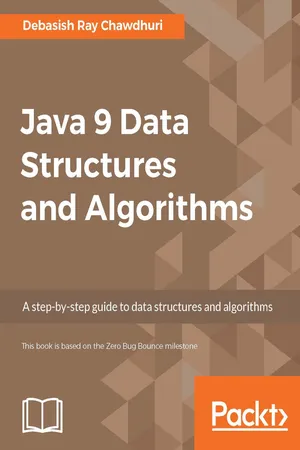
- 340 pages
- English
- ePUB (mobile friendly)
- Available on iOS & Android
Java 9 Data Structures and Algorithms
About this book
Gain a deep understanding of the complexity of data structures and algorithms and discover the right way to write more efficient codeAbout This Book• This book provides complete coverage of reactive and functional data structures• Based on the latest version of Java 9, this book illustrates the impact of new features on data structures• Gain exposure to important concepts such as Big-O Notation and Dynamic ProgrammingWho This Book Is ForThis book is for Java developers who want to learn about data structures and algorithms. Basic knowledge of Java is assumed.What You Will Learn• Understand the fundamentals of algorithms, data structures, and measurement of complexity• Find out what general purpose data structures are, including arrays, linked lists, double ended linked lists, and circular lists• Get a grasp on the basics of abstract data types—stack, queue, and double ended queue• See how to use recursive functions and immutability while understanding and in terms of recursion• Handle reactive programming and its related data structures• Use binary search, sorting, and efficient sorting—quicksort and merge sort• Work with the important concept of trees and list all nodes of the tree, traversal of tree, search trees, and balanced search trees• Apply advanced general purpose data structures, priority queue-based sorting, and random access immutable linked lists• Gain a better understanding of the concept of graphs, directed and undirected graphs, undirected trees, and much moreIn DetailJava 9 Data Structures and Algorithms covers classical, functional, and reactive data structures, giving you the ability to understand computational complexity, solve problems, and write efficient code. This book is based on the Zero Bug Bounce milestone of Java 9.We start off with the basics of algorithms and data structures, helping you understand the fundamentals and measure complexity. From here, we introduce you to concepts such as arrays, linked lists, as well as abstract data types such as stacks and queues. Next, we'll take you through the basics of functional programming while making sure you get used to thinking recursively.We provide plenty of examples along the way to help you understand each concept. You will get the also get a clear picture of reactive programming, binary searches, sorting, search trees, undirected graphs, and a whole lot more!Style and approachThis book will teach you about all the major algorithms in a step-by-step manner. Special notes on the Big-O Notation and its impact on algorithms will give you fresh insights.
Frequently asked questions
- Essential is ideal for learners and professionals who enjoy exploring a wide range of subjects. Access the Essential Library with 800,000+ trusted titles and best-sellers across business, personal growth, and the humanities. Includes unlimited reading time and Standard Read Aloud voice.
- Complete: Perfect for advanced learners and researchers needing full, unrestricted access. Unlock 1.4M+ books across hundreds of subjects, including academic and specialized titles. The Complete Plan also includes advanced features like Premium Read Aloud and Research Assistant.
Please note we cannot support devices running on iOS 13 and Android 7 or earlier. Learn more about using the app.
Information
Java 9 Data Structures and Algorithms
Table of Contents
Java 9 Data Structures and Algorithms
Credits
Table of contents
- Java 9 Data Structures and Algorithms